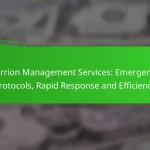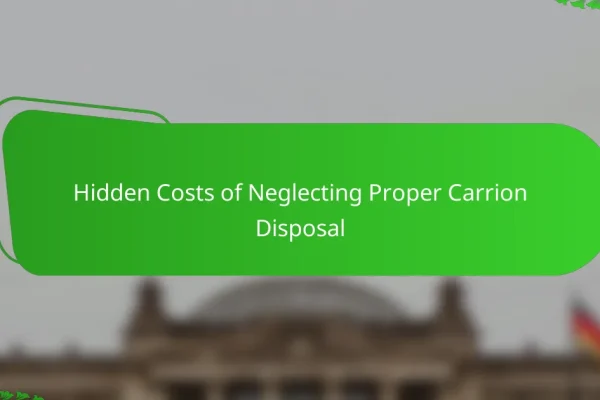What are the cost factors in carrion management services?
The cost factors in carrion management services include various elements that influence pricing, such as the type of service provided, the location of the service, the volume of carrion, regulatory compliance, and the equipment used. Understanding these factors helps clients anticipate expenses and make informed decisions when selecting a service provider.
Service type
The type of service significantly impacts costs in carrion management. Basic removal services may be less expensive than comprehensive management solutions that include disposal, sanitation, and odor control. Specialized services, such as those for hazardous materials or large animal carcasses, typically incur higher fees due to additional safety measures and expertise required.
Location
Geographical location plays a crucial role in determining the cost of carrion management services. Urban areas may have higher service fees due to increased operational costs, while rural regions might offer lower rates but could have longer response times. Local regulations and disposal facilities also vary, influencing overall pricing.
Volume of carrion
The volume of carrion directly affects the cost of management services. Larger quantities often require more resources and time, leading to higher charges. Service providers may offer tiered pricing based on the weight or number of carcasses, so clients should inquire about bulk rates if dealing with multiple animals.
Regulatory compliance
Compliance with local and national regulations can add to the cost of carrion management. Service providers must adhere to specific guidelines for safe disposal and environmental protection, which may require additional training and certification. Clients should ensure that their chosen provider is compliant to avoid potential fines or legal issues.
Equipment used
The type of equipment utilized in carrion management can influence costs significantly. Advanced machinery and specialized tools for handling and transporting carcasses may increase service fees. Clients should consider whether the investment in high-quality equipment justifies the potential for improved efficiency and safety in the management process.
How do service types affect costs in carrion management?
The type of service chosen for carrion management significantly influences the overall costs. Different services cater to various needs, with pricing reflecting the complexity, urgency, and methods involved in the removal and disposal process.
Standard removal services
Standard removal services typically involve scheduled pickups for deceased animals, often at a fixed rate. These services are suitable for routine cases and can range from low tens to a few hundred dollars, depending on the size of the animal and location.
When opting for standard services, consider factors like the frequency of service required and any additional fees for larger animals or specific locations. It’s advisable to compare quotes from multiple providers to ensure competitive pricing.
Emergency response services
Emergency response services are designed for urgent situations, such as roadkill or animals found in residential areas. These services usually come at a premium, often costing significantly more than standard removal due to the immediate nature of the response.
Costs for emergency services can vary widely, often starting from a few hundred dollars and increasing based on the urgency and time of day. It’s crucial to confirm the availability of 24/7 services and any extra charges that may apply for after-hours calls.
Specialized disposal methods
Specialized disposal methods include techniques such as cremation or composting, which may be necessary for certain types of animals or specific regulations. These methods often incur higher costs due to the additional processes and equipment required.
Pricing for specialized disposal can range from several hundred to over a thousand dollars, depending on the method chosen and local regulations. When selecting a disposal method, ensure compliance with local environmental laws and consider the long-term implications of each option.
What role does location play in pricing?
Location significantly influences the pricing of carrion management services due to variations in demand, local regulations, and available resources. Urban areas typically face higher costs due to increased operational expenses, while rural regions may have lower prices but also fewer service options.
Urban vs rural pricing
In urban settings, the cost of carrion management services often ranges from moderate to high due to factors like higher labor costs, transportation expenses, and increased regulatory scrutiny. Conversely, rural areas generally experience lower pricing, often in the low to mid-range, due to reduced operational costs and less competition.
However, rural customers may face longer response times and limited service availability, which can impact overall satisfaction. It’s essential for clients to weigh the trade-offs between cost and service quality when choosing a provider based on their location.
Regional regulations
Different regions have varying regulations that can affect pricing for carrion management services. Areas with strict environmental laws may impose additional fees for compliance, while regions with more lenient regulations might offer lower prices. Understanding local laws is crucial for estimating total costs accurately.
Clients should research the specific regulations in their area, as non-compliance can lead to fines or additional charges. Consulting with service providers about their compliance practices can also provide insight into potential costs.
Access to disposal facilities
The proximity to disposal facilities plays a vital role in determining the cost of carrion management services. Areas with easy access to licensed disposal sites typically benefit from lower transportation costs, which can translate into lower service fees. In contrast, locations far from these facilities may incur higher charges due to increased travel distances.
Clients should inquire about the disposal methods used by service providers and their proximity to disposal sites. This knowledge can help in comparing prices and understanding the factors that contribute to the overall cost of services.
How does the volume of carrion influence service costs?
The volume of carrion significantly affects service costs, as larger quantities require more resources for removal and disposal. Service providers often base their pricing on the amount of material they need to handle, which can lead to varying costs depending on the volume involved.
Pricing per weight
Pricing for carrion management services is often calculated based on the weight of the material. Providers may charge a set rate per kilogram or pound, with costs typically ranging from a few cents to several dollars per unit of weight. Heavier loads not only increase disposal fees but may also require specialized equipment, further impacting the total cost.
Bulk service discounts
Many service providers offer bulk discounts for larger volumes of carrion. These discounts can reduce the per-unit cost, making it more economical to manage larger quantities at once. For instance, a provider might offer a 10-20% discount for contracts involving regular pickups of substantial amounts, encouraging clients to consolidate their needs.
Frequency of service
The frequency of service also plays a critical role in determining overall costs. Regular, scheduled pickups can lead to lower rates compared to one-time or sporadic services. Clients who commit to a consistent service schedule may benefit from reduced pricing, as it allows providers to optimize their routes and resources.
What are the regulatory compliance costs in carrion management?
Regulatory compliance costs in carrion management encompass various fees and expenses associated with adhering to local and national laws. These costs can significantly impact the overall budget for carrion management services, making it essential for providers to understand and plan for them.
Licensing fees
Licensing fees are mandatory costs that businesses must pay to operate legally in carrion management. These fees can vary widely depending on the jurisdiction and the specific services offered, ranging from a few hundred to several thousand dollars annually.
Providers should research their local regulations to determine the exact licensing requirements and associated costs. Failure to obtain the necessary licenses can lead to fines and operational shutdowns.
Environmental regulations
Environmental regulations govern how carrion is handled to minimize ecological impact. Compliance with these regulations often requires investments in specialized equipment and training, which can add to overall costs.
For instance, companies may need to implement waste disposal methods that meet local environmental standards, potentially increasing operational expenses. Understanding these regulations is crucial for budgeting and avoiding penalties.
Health and safety standards
Health and safety standards are critical in carrion management to protect workers and the public. Compliance often involves costs related to safety training, personal protective equipment (PPE), and regular inspections.
Businesses should prioritize adherence to these standards, as non-compliance can result in serious legal repercussions and increased liability. Investing in proper training and equipment not only ensures compliance but also promotes a safer working environment.
How does equipment impact carrion management service pricing?
The equipment used in carrion management services significantly influences pricing. High-quality, specialized tools and vehicles can lead to higher costs due to their initial investment and maintenance, but they also improve efficiency and effectiveness in handling carcasses.
Types of Equipment
Common equipment in carrion management includes specialized vehicles, refrigeration units, and handling tools. Vehicles designed for transporting deceased animals often have features like sealed compartments to prevent odor and contamination. Refrigeration units are crucial for preserving carcasses until disposal, and handling tools ensure safe and hygienic removal.
Maintenance and Operational Costs
Regular maintenance of equipment is essential to ensure optimal performance and compliance with health regulations. High maintenance costs can arise from wear and tear, especially for vehicles used frequently in harsh conditions. Budgeting for these expenses is crucial for service providers to maintain competitive pricing.
Impact on Service Efficiency
Investing in advanced equipment can enhance service efficiency, reducing the time taken to manage carrion. For example, using hydraulic lifts can speed up the loading process, while specialized software can streamline scheduling and tracking. This efficiency can translate to lower overall costs for clients, making it a worthwhile investment.





